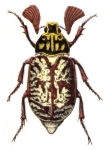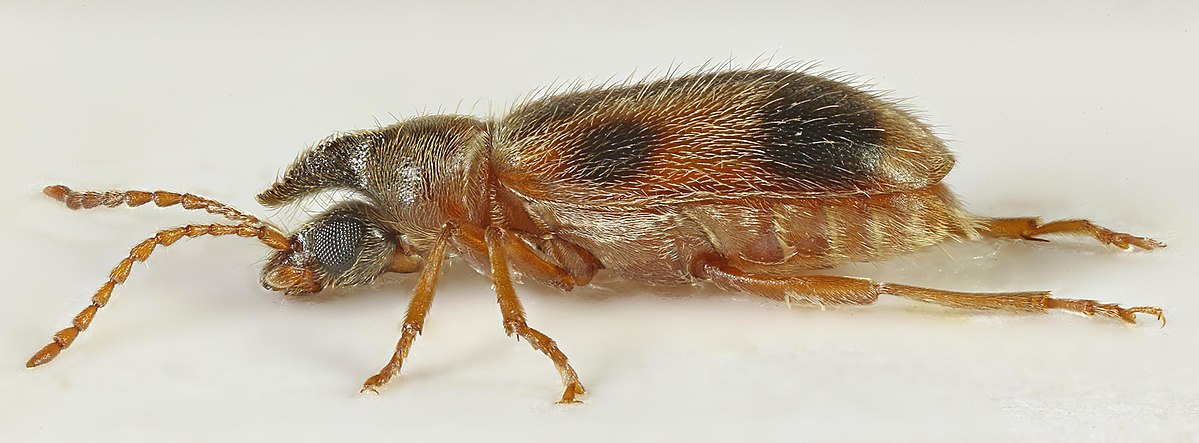|
Description / Habitats / Flora / Vertebrates / Insects / Invertebrates / What's that Bug? Home / Nestos Delta / Bibliography / About this site / Links / Contents / Galleries ____________________________________________________________________________ |
|
__________________________________________________________________________________________________________ THE ANT-LIKE FLOWER BEETLES (COL., ANTHICIDAE) OF THÁSOS
Notoxus monoceros (c) J. Graham The common name sometimes given to this family is a bit misleading as only a small percentage of the species are found in flowers. The adults, however, are ant-like and most species are active on the soil surface or are found amongst piles of dead and decaying vegetation where they are said to feed mainly on dead beetles, though presumably they are omnivorous on a wide range of invertebrates. They are characteristically narrow-bodied beetles with a distinctive pronotum that is constricted posteriorly and are usually black or dark brown, sometimes with patches of dull red or yellow. Some species have a conspicuous pronotal horn. A high proportion of the European species are inhabitants of the coastal fringe, especially on sandy soils, or the margins of rivers. In southern Europe they seem to take the place of rove beetles in such habitats. A few species are associated with compost or straw and as such they have been widely distributed across the holarctic. There is little information available on the Anthicidae of Thásos. The only records previously published appear to be those of Karnozickij (1959), who recorded four species in October 1942 and May 1943 (though one is thought unlikely), and M. & T. Cerruti added Stricticollis longicollis from Theologos in May 1973 (Bucciarelli 1976). My own collecting has added a further ten species (plus an unidentified female Cyclodinus sp.) to the island list (asterisked in the Checklist below). There will undoubtedly be more species to be found on Thásos, but there there appears to be very little published on the Aegean fauna as a whole. Oertzen (1886) lists 50 species for Greece, but there are over a hundred anthicid species recorded from Italy (Bucciarelli 1980). For comparison, Nardi & Mifsud (2003) report 21 and 25 species respectively from the Mediterranean islands of Sicily and Malta. All of the species recorded so far from Thásos are widespread in the Mediterranean area. The identification of most anthicid species is not straightforward and access to a reference collection is useful. However, there is a good key in the Fauna d'Italia series (Bucciarelli 1980) that covers the vast majority of species likely to be found on Thásos. This is in Italian but is copiously illustrated. Heberdey (1936) provides a key in German that includes all Notoxus species occurring in Greece except N. angustulusI am grateful to Dmitry Telnov and Paul Whitehead for help with identifications.
CHECKLIST Anthelephila (Formicomus) pedestris (Rossi, 1790) Anthicus axillaris Schmidt, 1842 * Anthicus fenestratus W.L.E. Schmidt, 1842 Anthicus flavipes (Panzer, 1797) * Anthicus niger (Olivier, 1811) * Anthicus tristis Schmidt, 1842 * Cyclodinus sp. * Endomia tenuicollis (Rossi, 1792) * Endomia unifasciata (Bonelli, 1812) * Hirticollis hispidus (Rossi, 1792) * Microhoria notata (Pic, 1901) * Notoxus cavifrons La Ferte-Senectere, 1849 * Omonadus (Anthicus) floralis (Linnaeus, 1761) Stricticollis longicollis (W.L.E. Schmidt, 1842) Stricticollis transversalis Villa & Villa, 1833 *
Unconfirmed records: Anthicus ater (Panzer, 1796) recorded by Karnozickij in 1943 needs checking as this species is similar to A. niger (which is widespread on Thásos) and has a more northerly distribution in Europe.
REFERENCES
Bucciarelli, I. 1976. Su alcuni Coleotteri Anticidi raccolti da M. e T. Cerruti nelle Isole di Creta, Corfu e Thasos, con descrizione di una nuova specie di Microhoria (Coleoptera, Anthicidae). Fragmenta Entomologica, 12: 133-142. Bucciarelli, I. 1980. Fauna d'Italia: Coleoptera. Anthicidae. Vol 17. Heberdey, R.F. 1936. Revision der paläarktischen Arten der Gattung Notoxus Geoffr. I. Die Verwandten des Notoxus monoceros L. Koleopterologische Rundschau, 22: 25-180. Karnozickij, N. 1959. Materialien zur Koleopteren-Fauna der Agäischen Küste und Insel Thasos. Izv. zool. Inst. Sof., 8: 237-253. Nardi, G. & Mifsud, D. 2003. A review of the Anthicidae of the Maltese Islands (central Mediterranean) (Coleoptera). Fragmenta entomologica, 35: 77–127. Oertzen, E. v. 1886. Verzeichniss der Coleopteren Griechenlands und Cretas. Berliner Entomolog. Zeitschrift, 30: 189-293.
|

















